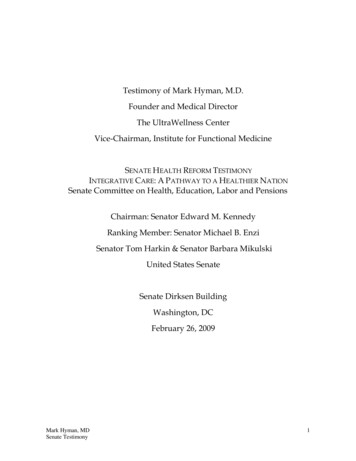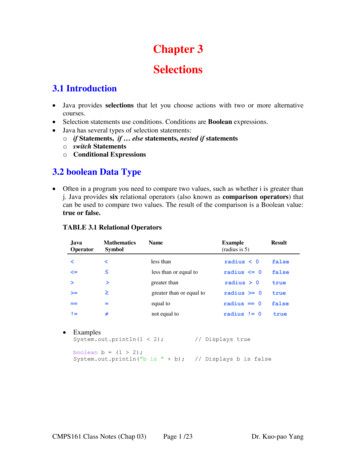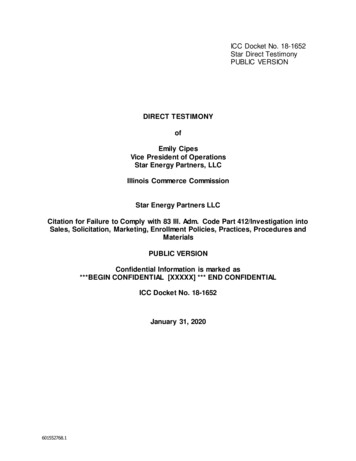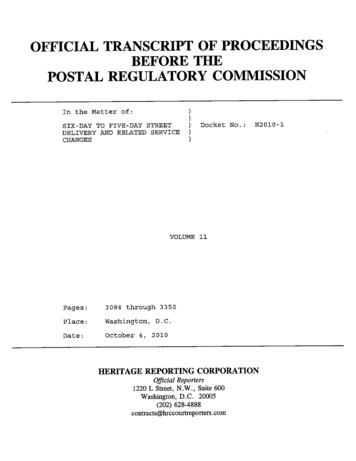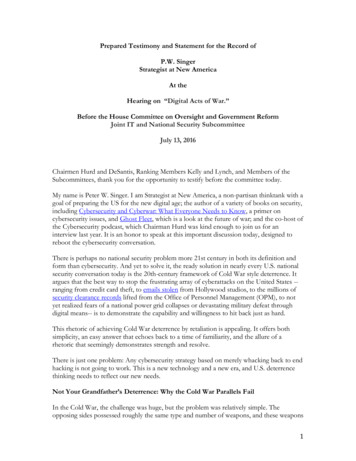
Transcription
Prepared Testimony and Statement for the Record ofP.W. SingerStrategist at New AmericaAt theHearing on “Digital Acts of War.”Before the House Committee on Oversight and Government ReformJoint IT and National Security SubcommitteeJuly 13, 2016Chairmen Hurd and DeSantis, Ranking Members Kelly and Lynch, and Members of theSubcommittees, thank you for the opportunity to testify before the committee today.My name is Peter W. Singer. I am Strategist at New America, a non-partisan thinktank with agoal of preparing the US for the new digital age; the author of a variety of books on security,including Cybersecurity and Cyberwar: What Everyone Needs to Know, a primer oncybersecurity issues, and Ghost Fleet, which is a look at the future of war; and the co-host ofthe Cybersecurity podcast, which Chairman Hurd was kind enough to join us for aninterview last year. It is an honor to speak at this important discussion today, designed toreboot the cybersecurity conversation.There is perhaps no national security problem more 21st century in both its definition andform than cybersecurity. And yet to solve it, the ready solution in nearly every U.S. nationalsecurity conversation today is the 20th-century framework of Cold War style deterrence. Itargues that the best way to stop the frustrating array of cyberattacks on the United States -ranging from credit card theft, to emails stolen from Hollywood studios, to the millions ofsecurity clearance records lifted from the Office of Personnel Management (OPM), to notyet realized fears of a national power grid collapses or devastating military defeat throughdigital means-- is to demonstrate the capability and willingness to hit back just as hard.This rhetoric of achieving Cold War deterrence by retaliation is appealing. It offers bothsimplicity, an easy answer that echoes back to a time of familiarity, and the allure of arhetoric that seemingly demonstrates strength and resolve.There is just one problem: Any cybersecurity strategy based on merely whacking back to endhacking is not going to work. This is a new technology and a new era, and U.S. deterrencethinking needs to reflect our new needs.Not Your Grandfather’s Deterrence: Why the Cold War Parallels FailIn the Cold War, the challenge was huge, but the problem was relatively simple. Theopposing sides possessed roughly the same type and number of weapons, and these weapons1
affected them both in roughly the same way. The attack to be deterred was a clear andobvious one, with clear attribution that assured mutual and equal destruction in a massivemushroom cloud. Thus, building up a potent offense, and being willing and able to use it,translated directly into deterrence.Today, though, there are seven key differences that mean the Cold War model of deterrenceis not an apt one to deal with the threats of a new digital world.First is the different civilian versus military makeup of the issue. In the Cold War, whilesupport of the population mattered, the basic competition of deterrence came down to thetwo sides’ defense and strategic nuclear establishments. Today, the domain in question iscivilian-owned and operated (even 98% of US military communications go over civiliansystems), meaning everything from the technology itself is to many of the most importantplayers are civilian, from the protectors (civilian government agencies like the FBI and DHSto cybersecurity firms) to the targets themselves (civilian agencies like the OPM or NASA tothe individual victims of over 1 Trillion in cybercrime).The relative position of the military and civilian world is also reversed. In the Cold War, themilitary led the way, including even funding the creation of the Internet itself. Today, it is thecivilian world that is often doing cutting-edge work in everything from finding new zero daysto building new means of encryption. This applies even to the human resources side. Therewas no private market in the Cold War for missileers in the same way that there is abooming cybersecurity industry that rivals and sometimes surpasses talent inside of themilitary, as well as makes it harder to retain.Second, today, there is no “mutual” to balance, let alone “assured” nature of any action, nor“destruction” of the same scale. The United States is arguably more vulnerable tocyberattack than any of its adversaries, largely because of its wide commercial, military, andcultural dependence on the Internet. This feels daunting, but is, on balance, a good thing.North Korea, for instance, may be in the seemingly enviable position of being the world’sleast vulnerable nation to cyberattack. But this seeming strength comes at the cost of globalisolation, dictatorship, and an economy that relies on military-run pig farms.Likewise, while conventional and nuclear weapons have highly predictable, i.e. “assured,”consequences, cyber attacks are uncertain by their very nature. Their impact depends onmultiple, often unpredictable actions, and often have second and third orders effectsunanticipated by their designers. The (at the time) covert operation to deploy Stuxnet in2009-2010, for instance, was arguably one of the most successful digital attacks in history, asit successfully sabotaged Iranian nuclear research equipment. Yet, the software wasdiscovered as it popped up in some 25,000 other computers located around the world, fromBelarus to India, contrary to the operational plan.Finally, while there are great threats and costs from cyber attack, no human has yet beendirectly hurt or killed by one. Of the very few attacks that have caused physical impact (threeare most commonly recognized at this time: Stuxnet, the 2015 Ukrainian power grid hack,and a suspected attack in 2014 at a German steel factory), the actual destructive damage hasso far been limited to less than a grenade could do, let alone the Hiroshima device. Lookingforward, we can envision cyber attacks that would cause great physical damage and even2
death, such as the take down of a city or even entire region’s power grid. Yet, even in suchworst fears, the death toll would still be orders of magnitude smaller than the toll of a singlenuclear bomb, let alone the all out thermonuclear war between the US and USSR thatthreatened human existence and thus was truly MAD.Third, there is an inverse relationship to conventional military strengths and weaknesses thatguided us in the past. Underpinning Cold War deterrence strategy was that the United Statesperceived itself weaker than the Soviet Union in conventional warfighting, worrying about aquick takeover of Western Europe by a larger Red Army. Thus, it relied on the threat ofnuclear response to avoid an unequal conventional war. Today, we face an oppositedilemma. It is the United States that has the conventional edge on its adversaries and ourattackers see cyberattacks as their asymmetric way to work around a power imbalance. Thispoints to a key aspect in our deterrence today: our willingness and ability to escalate in theopposite direction as the Cold War. If an act in cyberspace is an “act of war,' we retain theoption to respond with acts of war in other domains where we may have an even greatadvantage, with the knowledge of that fact providing an added dose of deterrence.Fourth, the timing is fundamentally different. The physics of a ballistic missile’s speed andarc determined conceptions of deterrence during the Cold War. The critical 30 minutes itwould take an intercontinental missile to fly across continents was essential to planning andstrategy.In cybersecurity, however, time operates by different rules. While cyberattacks seeminglymove at digital speed, the ones that are actually effective take months or years to plan,organize, conduct, and -- most importantly -- detect. An attacker often carries out longperiods of preparation and intelligence gathering, all with the goals of gaining and keepingentry. The alleged Chinese OPM hacks that stole sensitive data of over 21 million Americansmay be on policymakers’ minds now, but the attack actually started as early as March 2014,well over a year before it became an issue of defender or Congressional awareness. Indeed,the average time it takes a victim of a cyber attack to detect that they have been breached is205 days. In its study of APT1, a hacking campaign linked to the Chinese People’sLiberation Army (PLA) Unit 61398, the security firm Mandiant found that the unit spent aslong as 5 years undetected inside several of its targets’ networks.It is not just about preparation or detection; the timeline of reaction is also fundamentallydifferent. As opposed to the need to act within the tight, 30-minute window of Cold Warmissiles, in cybersecurity the defender’s best move may well not be to strike back as rapidlyas possible, but to show no outside awareness of the ongoing attack. This complicates theattacker’s damage assessments. It even allows the victim to turn the tables and steer theattacker into areas where they cannot do harm, or feed them false information thatundermines their whole endeavor.The weapons also come with different timelines -- not just in their creation, but also in theirutility. The Minuteman Intercontinental Ballistic Missile (ICBM) was conceived in 1956, andserved as the central tool of U.S. nuclear deterrence for the next three decades of the ColdWar. But its utility did not stop there. Indeed, roughly 450 Minuteman III missiles stillprotect the United States today, with plans for them to serve to 2030 or even beyond. Bycontrast, the most dangerous cyberweapons depend on new “zero days” -- vulnerabilities the3
victim is not yet aware of. Yet, what is most potent today, a single software patch can renderinert tomorrow.Fifth is a fundamental difference in the players of the game itself, in their makeup, number,and interests. The actors who the United States is supposed to be cyber deterring are farmore diverse than the Cold War list that included only the Soviet Union (which notably hada fairly similar power status and even nuclear doctrine). More than 60 countries have cybermilitary capabilities, ranging from large and powerful states to weak regimes. Non-stateactors also are in the game, and they range from transnational criminals to hacktivistnetworks to maybe the most difficult of all, proxy groups taking advantage of the grey spacein between, sometimes working on behalf of states and sometimes on their own. Moreover,it is not just the different numbers, but that each actor comes with vastly different interestsand stakes in the game. Akin to terrorism or crime, some players have assets or positionsthey greatly value, and thus are deterrable, while some value mere chaos, and thus are not.Sixth, as diverse as the players are, another difference is the diversity of attacks they mightcarry out. Those vary from theft of intellectual property to online dumps of embarrassingHollywood studio emails, to the (not yet realized) risks of a massive kinetic attack on criticalinfrastructure, such as using Stuxnet style digital weaponry against industrial control systemsto collapse power grids or transportation networks. So when people talk today about theirfears that US cyber deterrence has failed, they are both right and wrong. Not every kind ofattack is being thwarted, yet the worst kind of attack that major states are capable of areindeed being deterred.This variety reinforces a key aspect in the discussion of digital war: not all attacks inconstitute an act of war. They range from acts of theft to protest to espionage that rangesfrom sabotage to subversion to the fear of an actual act of war, traditionally defined aspolitical violence on a mass scale. The stealing of a secret, for instance, is vexing, but nonation has ever gone to war over such an event. Such distinctions are important not just indefining what is and isn’t war, but also what is and isn’t a US military responsibility. If everycyber threat becomes a military issue, not only is that inefficient in term of applying the rightresponse, but it also over burdens an already busy US military.While attribution is often identified as a central problem in cybersecurity and acts of wardiscussions -- unlike an ICBM, a cyberattack does not emit a clear plume of smoke toidentify the attacker -- the existence of diverse attackers and diverse attacks muddies thewater further: it can be incredibly complicated to determine the intent of an attack, even if itsform and sender are known. When a Russian criminal group with ties to Russian intelligencewas detected attacking U.S. banks in 2014, for instance, the security community debatedwhether it was regular old cybercrime, or an attack linked to Russian state interests, designedas a response to the sanctioning of the regime for its invasion of Ukraine. But even then, wasthe attack a retaliation that got caught? Or was it akin to a nuclear test in a crisis, a signal thatwas actually intended to be detected, as a warning of greater consequences if the UnitedStates pushed further?The problem of comparison when it comes attack types does not stop there. Unlike in theCold War, some cyber attacks that target the United States are the kind of attacks that wewould actually like to carry out ourselves, or, in fact, already do. US Military and White4
House officials reacted far more mildly to the OPM email breach than many in the publicexpected. Why? In part, it is because attacks targeting a government agency’s networks arethe bread and butter of the online espionage operations the United States implementsagainst other governments. As Director of National Intelligence James Clapper said in June,2015 after the discovery of the OPM attack, “You have to kind of salute the Chinese forwhat they did. If we had the opportunity to do that, I don't think we'd hesitate for a minute.”When it comes to attacks like on the OPM, instead of telling the attackers “Shame on you,”we need to look in the mirror and say “Shame on us for making their job so easy.”Seventh, and perhaps where the Cold War parallels fall short the most, is the idea thatbuilding up like offensive capabilities will deliver deterrence. This is a constant refrain: notjust the need to build up U.S. cyber offense, but the need to make sure others know theUnited States has those capabilities. As James Cartwright, the four-star Marine Corps generalwho led much of the initial U.S. strategy in cyber issues until his retirement in 2011, said,"You can’t have something that’s a secret be a deterrent. Because if you don’t know it’sthere, it doesn’t scare you."The problem is that the evidence so far disproves this link. Unlike concerns over bomberand missile “gaps” during the Cold War (which instructively turned out to be wrong), theUnited States’ offensive cyberspace capabilities have never been in question. And for anyonesomehow in doubt, there have been series of public releases that further confirmed it. Theseincluded Washington policymakers’ leaks designed to take credit for Stuxnet, and thenEdward Snowden’s 2014 dump of some 1.4 million NSA documents. While Snowden’sdisclosures obviously angered his former employers, they also show that the experts at FortMeade have much to be proud of. The NSA has developed unmatched, amazingly exoticcapabilities, from a mindboggling scale of global monitoring devices to new classes of cyberweapons that use radio signals to jump software over the previously protective physicaldivides between systems. And the leaks show the capability is not mere lab work, but thatthe NSA has used them in operations against targets ranging from Iranian nuclear researchfacilities to Chinese command networks.Yet despite this clear and continual gain in offensive capability and the demonstration of itspotency, attacks on the United States have only grown, in both number and in intensity. Inthe year after the Snowden leaks proved the U.S.’s offensive prowess, there was 55% moredata lost from hacking than the year before -- and that does not even include the operationstargeting major government sites like OPM or the Pentagon’s Joint Staff network that beganin that same period.In sum, the flaw is not with deterrence theory, nor with cyber weapons’ utility. Rather, it iswith the framing of the problem. We too often try to peel off the bumper-sticker version ofcomplicated Cold War deterrence debates and apply it to a more complicated present andfuture.A Deterrence Path ForwardSo what to do instead? There are the three better ways for the United States to draw theright lessons from the Cold War and reach more effective and more obtainable cyberdeterrence goals.5
1) Set the NormsThere is a huge value in delineating clear lines of behavior in a combined commercial,espionage, and warfighting space still at its infancy. During the height of the Cold War, thesuperpowers may have been a button press away from thermonuclear annihilation, but theystill found a way to agree on certain norms. Sometimes these were formal arms treaties;other times they were tacit codes of conduct that guided everything from limiting spy-on-spykillings to avoiding interference with nuclear commands. Cutting across all was the goal ofavoiding miscalculations that could unintentionally escalate into outright war.Today, at the global level, much of the norm discussion in the UN GGE process has beenabout establishing potential rules of the road for military conflict in cyberspace. Inside USdefense and political circles, by contrast, much of cyber deterrence and norm discussions hasbeen on how to end the spate of government-enabled attacks on intellectual property, whichwas at the center of the agreement hammered out this fall between the United States andChina. There is mixed reporting since on the impact of the agreement. The overall numberof IP theft attacks are reportedly down, with some crediting the reduction to the agreement,while others credit unrelated forces like domestic Chinese government anti-corruptionactivities.What is clear is that three activities will continue. Theft of intellectual property is integral tothe Chinese mercantilist economic model, so while the number is down, the overall practiceis, and by all indications, will still continue. In turn, the United States is wedded to the openflow of information, but Beijing sometimes interprets platforms that share freedom ofspeech as “information attacks” that threaten its internal stability. So China will perceiveitself under continued attacks of a different kind from the US. And both sides, whosemilitaries are engaged in an arms race in the Pacific, will continue to engage in espionage tobetter position themselves if there was outright war.This dynamic illustrates how reaching a formal prohibition on cyberattacks of any and allkinds between the 21st century powers unlikely. It does not mean, however, that there is novalue in engagement and norm building. Rather than a treaty or agreement that unrealisticallytries to create a Cold War-style regime of deterrence or arms control, the two sides need toflesh out a mutual understanding of the new rules of the game. Both sides must understandthat their opponent will continue to conduct cyberactivities ranging from espionage to theft.The most important goal is not to stop every cyberattack, but to keep them from escalatinginto something far more dangerous.This leads to a fundamental change in the typical deterrence discussion. In the Cold War,everything was targeted, from military bases to cities full of civilians, but outright attackscrossed the line. Today, the situation is inverted. While unwanted, some cyberattacks willhave to be allowed, while certain targets must be made anathema.This returns to the point that not all 'cyberattacks' are act of war. No one wants their statesecrets stolen, for example, but it is part of the expected dance of great powers incompetition. By contrast, there are other attacks that may not be clear acts of war, but theyshould be a focus on norm building to prohibit, as they make war more likely. Introducing6
the digital equivalent of a dormant Tasmanian devil into a nuclear power facility’s operatingsystem should be off limits to both sides, not merely because it would be disproportional ifactually used, but because simply the act of deploying it risks accident or event interpretationas an incredibly escalatory step of preparing for war.Continuing to set and reinforce these guardrails has to be one of the key activities in thevarious bilateral and multilateral efforts in this space, from U.S. agreements on cybersecuritywith to the two U.N. General Assembly resolutions that call for respect of the laws of war incyberspace, to the Tallinn Manual process.Yet, for all the laudable work in building norms, what threatens to undermine norm-buildingis inaction when acts clearly violate the norms. One of the consistently agreed upon norms isnot to target clear civilian infrastructure with the intent to cause widespread damage (asopposed to monitor or steal information), even more so outside of declared war. Suchattacks are viewed as violating the norms of necessity and proportionality that underpin thelaws of war.Yet, in December of 2015, this line was clearly crossed in an attack on the Ukrainian powergrid. More than 230,000 civilians lost power, in a what has been positively identified as acyber attack by both local authorities and international experts, and US officials haveidentified Russia as the attacker (going back to the issue of proxy actors, they have not madeclear whether it was government or non government but government linked actors). It wasthe first proven takedown of a power grid, the long discussed nightmare scenario. Yet, in thestory of action and consequence that is the key to maintaining norms, we had clear action,but as yet no clear consequence.2) Deter Through DiversityNothing above argues against building up offensive capabilities for cyberspace.Cyberweapons have proven their value in espionage, sabotage, and conflict. And the digitaldomain will be as crucial to warfare in the 21st century as operations on land, air, and sea.Indeed, the cyber front of any war between the United States and China would feature notjust military units like Cyber Command or the PLA’s Unit 61398, but also non-state actorsthat might range from Chinese university cyber militias to Anonymous hackers joining in thefight with their own goals and modes, much as what has happened in the online ISIS battles.This is a good illustration of another misperception: Cyberweapons are increasingly usefultools of espionage and war, but they are not akin to “weapons of mass destruction.” Thefear of a single big thermonuclear tit for tat maintained the nuclear balance; indeed, treatingnuclear weapons as no different from conventional weapons is what many feared wouldunravel MAD. Offensive cyber capabilities, by contrast, are a key part of the toolkit to beused in both hot and cold conflicts. Indeed, the US has already crossed this line by openlyadmitting to conducting offensive cyber operations against ISIS.We can and should continue to build our offensive cyber capabilities. The key to theiroptimal effectiveness, though, will be in doctrine building and integration; i.e. how we meldactivities in the cyber domain with conventional operations in the air, sea, land, and space.Achieving ranges from bolstering training and operational planning to clarifying command7
and control relationships. Indeed, if there is a historic parallel to worry about, it is not ColdWar battles never fought, but a digital version of the 1942 Battle of Kasserine Pass, where aUS military failure to bring together technologies and units across domains helped contributeto the early losses of World War II.That a cyber weapon is not like a WMD does not mean the United States has no options toexact costs on would-be attackers to change their calculations, the goal of deterrence outsideof war. Indeed, it may even have more. Just as the timeline is stretched out and the playersare proliferated as compared to the Cold War, the options for responding are proliferated.True deterrence building responses can come after the fact and in other realms. For instance,our only option is not to respond to IP theft by taking the exact same action, in the samedomain. The defender can also go after other assets valued by the attacker or even thosevalued by third party actors, from sanctioning companies benefiting from stolen fruit topersonal level actions like threatening to revoke valued visas for regime leader familymembers to attend US schools. Indictments of individuals involved in hacking might serve apurpose not of actual prosecution and punishment, but as a different means of surfacingdata about attribution, or to make access to the global financial system more difficult. Thisdynamism complicates things to a degree that even the most brilliant Cold War strategistwould find vexing.The raised options increase the complexity we have to work through. Leaders will have togame out not merely the first two moves of the response -- the simple “shoot and shootback” dynamic that was the whole of thinking they needed in any Cold War nuclearexchange -- but plot out moves in multiple stages by multiple actors. For instance, thesuccess of legal or trade sanctions will depend not just on whether a punishment for pastattacks would stop future attacks, but also what the United States is prepared and willing todo in response to loss of market access were China, say, to respond in kind against someAmerican firms.Creativity and flexibility will beat simplicity in this dynamic. Indeed, the United States mayeven steal ideas from one attacker’s playbook as a useful tool against another. From Sony toSnowden, leaked emails and documents have been among the most vexing incidents forcybersecurity. But the irony is that here the lack of mutuality is to our advantage; the U.S.’ssystem of government and open society is least vulnerable to them. For all the sturm anddrang over revelations of questionable metadata collection and Angelina Jolie gossip, U.S.political and societal stability has never been at risk from this practice of what is known as“doxing,” Yet, as Catherine Lotrionte at Georgetown University has noted, threatening toreveal the private financial data of a regime’s leader, his family, or allied oligarchs, may be farmore potent. In thinking through such targeting for cyber deterrence, we can see sometimessee what regimes fear most by what they ban. Witness the different responses to the PanamaPapers, which were short-lived news articles of interest in the US, but led the Chinesegovernment to censor discussion of even the word Panama on its social media.Across all these efforts, the goal is not to prevent all attacks, like MAD did with nuclearweapons. Rather, it is to change the potential attacker’s calculus on whether an individualcyberattack will be beneficial in the final tally.3) Shake It Off: Build Resilience8
The third, most apt lesson from a deeper dive into the Cold War deterrence debates is thevalue not just in raising the costs, but also in limiting the adversary’s potential gains. This isknown as “deterrence by denial” -- making attacks less likely by reducing their likely value. Intoday’s parlance, this is the crucial idea of “resilience.” If Congress wants to evolve thecybersecurity conversation, it should move resilience to the center of it.In both strategy and football, sometimes the best defense is a good defense. A half-centuryago, strategic planners did not just talk about striking back as the key to deterrence, but alsoon having “survivable” counter or “second strike” missiles that would nuke the other side,even if it tried a sneak attack. This is why the United States put missiles on expensivesubmarines and in hardened siloes.Resilience today is about creating the capacity to power through an attack and shake it off,thereby limiting the gains to the attacker and recovering rapidly from any losses.Building resilience is not as politically appealing as striking back with new cyberweapons,because it means accepting that this is a digital world where the risk of cyberattacks is notgoing away. Yet it is more realistic, as well as where the United States would be getting farmore deterrence bang for its buck. Most importantly to the problem we face in the diversityof cyber problems, it is useful for responding to them all. The great value of buildingresilience is that it applies to any kind of attacker and any kind of attack.Unfortunately, despite the attention, rhetoric, and money the United States governmentspends on cybersecurity, it is still far from resilient against cyber attack. For every gain, thereis still a major gap to be closed. In the military, the construction budget alone for FortMeade, the combined headquarters of the NSA and Cyber Command, will reach 2 billionby the end of 2016, and the force will add another 4,000 personnel. Yet, the Pentagon’s owntester still found “significant vulnerabilities” in nearly every major weapons program.In the broader federal government, the cybersecurity budget for 2016 is 35 percent higherthan it was just two years ago. Yet half of security professionals in these agencies thinkcybersecurity did not improve over that same period. The reasons range from continuedfailure to follow basic measures – the requirement for personal identification verificationcards dates back to 2004 but still is not fully implemented -- to a failure to take seriously thelong-term nature of the threats we face, most importantly in a world of renewed geopoliticalcompetition. The exemplar of these failures was the OPM, which dealt with some of themost sensitive government information, and yet outsourced IT work to contractors in China-- despite warnings going back to 2009.In October, the White House issued a post-OPM "Cybersecurity Strategy andImplementation Plan" that describes a key
including Cybersecurity and Cyberwar: What Everyone Needs to Know, a primer on cybersecurity issues, and Ghost Fleet, which is a look at the future of war; and the co-host of the Cybersecurity podcast, which Chairman Hurd was kind enough to join us for an interview last year. It is an honor to speak at this important discussion today, designed .







